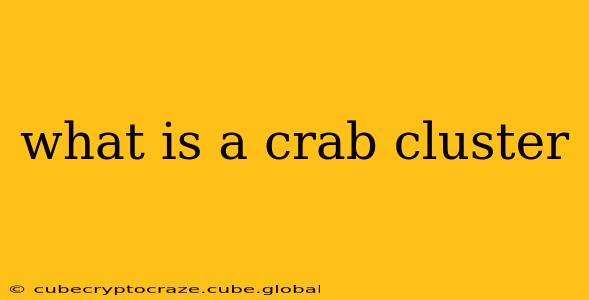Crab clusters, also known as crab aggregations or congregations, are fascinating natural phenomena where numerous crabs gather in a relatively confined area. These aren't simply random groupings; they represent complex social behaviors driven by a variety of factors, making them a compelling subject of study for marine biologists and ecologists. Understanding crab clusters requires delving into their formation, the species involved, and their ecological significance.
Why Do Crabs Form Clusters?
This question lies at the heart of understanding crab clusters. Several key factors contribute to their formation:
-
Mating and Reproduction: Many crab species congregate during breeding seasons to increase the chances of successful mating. The sheer density of individuals in a cluster dramatically improves the odds of encountering a potential partner.
-
Feeding Opportunities: Abundant food sources often attract large numbers of crabs. Imagine a particularly rich patch of algae or a concentrated area of prey – it's a buffet for crabs, leading to a feeding frenzy and a dense cluster.
-
Protection from Predators: While seemingly vulnerable in large numbers, the sheer mass of crabs in a cluster can act as a deterrent to some predators. The confusion and potential for injury can make it less appealing for predators to target a dense crab cluster.
-
Shelter and Habitat: Certain locations provide superior shelter and protection from harsh environmental conditions. Cracks in rocks, underwater caves, or dense seaweed beds can act as attractive aggregation points, providing refuge from currents, waves, and predators.
-
Environmental Factors: Temperature, salinity, and tidal currents can all influence crab distribution. Favorable conditions in a specific area might draw crabs together, forming a cluster.
What Types of Crabs Form Clusters?
Crab clusters aren't limited to a single species. Many crab species exhibit clustering behavior, though the specific triggers and characteristics of the clusters can differ significantly depending on the species. Some well-known examples include:
-
Dungeness crabs ( Metacarcinus magister): These commercially important crabs often aggregate during molting and mating seasons.
-
Blue crabs (Callinectes sapidus): Known for their migrations, blue crabs can form large aggregations in estuaries and coastal areas.
-
Shore crabs (Carcinus maenas): These adaptable crabs form clusters in various habitats, often driven by food availability and shelter.
The specific species involved will significantly influence the size, structure, and behavior of the crab cluster.
How Big Can Crab Clusters Get?
The size of a crab cluster is highly variable. Some may consist of just a few dozen crabs, while others can encompass thousands or even millions of individuals. The size is largely determined by the factors mentioned earlier, including food availability, breeding season, and habitat suitability. Large-scale aggregations are truly spectacular sights to behold underwater.
What is the Ecological Significance of Crab Clusters?
Crab clusters are not just interesting biological occurrences; they play a crucial role in the marine ecosystem:
-
Nutrient Cycling: The concentrated activity of a large crab population impacts nutrient cycling within the immediate environment. Waste products, molted shells, and the consumption of organic matter contribute to the nutrient dynamics of the habitat.
-
Predator-Prey Interactions: Clusters can significantly influence predator-prey interactions, impacting the populations of both crabs and their predators.
-
Habitat Modification: In some cases, large crab clusters can even modify their immediate habitat. For example, their burrowing activity can alter sediment structure and influence other organisms.
Are Crab Clusters Always Beneficial?
While crab clusters offer various advantages, they can also have negative consequences:
-
Increased Competition: High densities can lead to increased competition for food and resources, potentially resulting in reduced growth rates and survival.
-
Disease Transmission: Close proximity increases the risk of disease transmission among crabs.
-
Vulnerability to Fishing: Large aggregations can make crabs more vulnerable to overfishing.
In conclusion, understanding crab clusters requires appreciating the intricate interplay of biological, ecological, and environmental factors. These intriguing aggregations provide valuable insights into crab behavior, population dynamics, and the overall health of marine ecosystems. Further research is continuously unraveling the mysteries of these remarkable marine phenomena.
